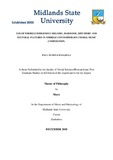Please use this identifier to cite or link to this item:
https://cris.library.msu.ac.zw//handle/11408/3532| Title: | Use of Ndebele indigenous melodic, harmonic, rhythmic and textural features in Ndebele contemporary choral music composition. | Authors: | Bajilla, Paul Dumisani | Keywords: | Ethnic identity Ndebele Ndebele music-culture |
Issue Date: | 2018 | Publisher: | Midlands State University | Abstract: | Ndebele particularistic origin and ethnic identity has a pre-colonial, colonial and post-colonial origin. Its origins are lodged within the complex nation-building project initiated by King Mzilikazi Khumalo and taken further by his son and successor King Lobengula Khumalo. A historically informed, careful and nuanced analysis of the evolution of Ndebele particularism should also consider such concrete historical factors as the Mfecane Revolution and Nguni-Sotho nation building strategies of the 1820s, as well as the role of colonialists and African nationalists in pushing the evolution of the country towards self-determination along bifurcated ethnic lines. The historiography of AmaNdebele is fully documented in chapter one, which also attempted to auntentic the author as an emic researcher as well as qualifying the status of the respondents as of Ndebele Descent. At the present moment the Ndebele people occupy the Southern region of Zimbabwe stretching from Limpopo to Zambezi, Shangani to Ramaqhuebana, a region refered to as Matabeleland. As such music creation/composition occupies a focal position in music-culture of the Ndebele people. Approaches to composition have, over the years, been hinged on western paradigms. What this thesis sets out to do is to examine, through a study of the selected personal works and demonstrative personal compositions, how the selected compositions have sought to evolve a new national idiom of Ndebele Art music. The aim of this study was to explain the creative processes in the Ndebele indigenous oriented choral music composition. The purpose was to investigate the emergence of artistic novelty out of the Ndebele creative forms, rhythmic, harmonic, melodic, and textural features that are embodied in their traditional or indigenous Ndebele music-culture. Thus, the main aim was to assess how such dynamics and artistic forms have provided the basis for the development of ‗new music‘ idioms in contemporary Ndebele compositions. The study adopted a textual analysis, hermeneutics and textual criticism research design in which empirical data on traditional Ndebele song-dance styles were collected through an ethnographic approach hence the use of qualitative research techniques. Ethnographic methods of participant observation and interviews, and informed by Onyeji‘s (2002) research-composition, with supporting theoretical positions as (a) the individual-community dichotomy in Ndebele philosophy, (b) differential psychology, (c) interpretive innovation, and (d) socio-musical practice, were used. Content and structural analysis of data collected revealed that analysis of a wide range of collected traditional Ndebele songs can provide a wide range of normative structural and stylistic features as pre-compositional resources in Ndebele indigenous contemporary choral composition. Of interest is that an autoethonographic method which recommends studying the ‗self‘, was employed. The selected contemporary compositions exhibited use of Ndebele indigenous creative forms, rhythmic, melodic, harmonic and textural features. The Ndebele linguistic reference was evident in the compositions. In a nutshell, three main elements typified the structural outline of the selected 5 works as the reliance on the poetic text as a formal prop; the use of the element of continuous variations; and the preponderant use of instrumental-dance conceived (clap-dance vocalism) accompaniment to realise change of textual content and mood. In consolidating the afore-mentioned theoretical positions, the works were examined in the context of proposed Music-cultural Dichotomous guidelines of structural analysis, which served as analysis rubric to illustrate the interaction between the traditional Ndebele idioms with Western elements in a cross-music-cultural setting. The proposed guideline template is fully discussed in chapter four, and has been used in analysing works in chapters five and six. The proposition of such analysis rubric is an endeavour to help in the provision of a relevant analytical approach which can be employed in studying other works by African composers which have a similar cultural conception to those examined in this research. Accordingly, one of the functions of the analyses in this research was to offer a cultural understanding which is likely to be different from a Western context, and by doing so provide a clearer understanding of the structural and stylistic features of the choral works under study. | URI: | http://hdl.handle.net/11408/3532 |
| Appears in Collections: | Theses |
Files in This Item:
| File | Description | Size | Format | |
|---|---|---|---|---|
| BAJILLA FINAL EDITED.pdf | Full Text | 12.91 MB | Adobe PDF |  View/Open |
Page view(s)
340
checked on Dec 19, 2025
Download(s)
582
checked on Dec 19, 2025
Google ScholarTM
Check
Items in MSUIR are protected by copyright, with all rights reserved, unless otherwise indicated.



